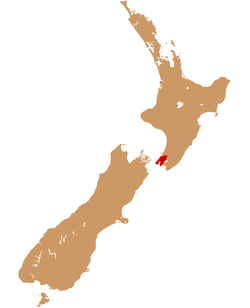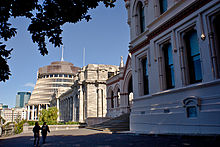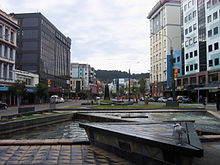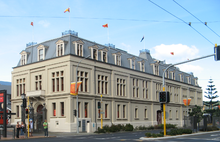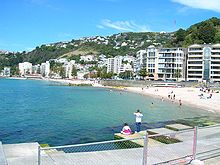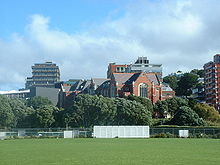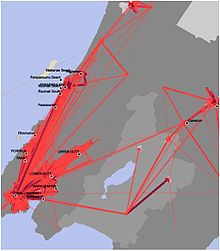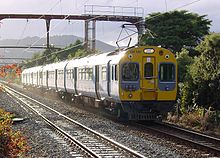
Wellington
Background to the schools Wikipedia
This selection is made for schools by a children's charity read more. Sponsor a child to make a real difference.
| Wellington | |
|---|---|
| — Main urban area — | |
| Wellington Harbour and skyline viewed from Mount Victoria | |
| Nickname(s): Harbour City, Welly | |
| Wellington urban area within New Zealand | |
| Coordinates: 41°17′20″S 174°46′38″E | |
| Country | |
| Region | Wellington |
| Territorial authorities | Wellington City Lower Hutt City Upper Hutt City Porirua City |
| Area | |
| • Urban | 444 km2 (171 sq mi) |
| • Metro | 1,390 km2 (540 sq mi) |
| Lowest elevation | 0 m (0 ft) |
| Population (June 2012 estimate) | |
| • Urban | 395,600 |
| • Urban density | 890/km2 (2,300/sq mi) |
| Time zone | NZST ( UTC+12) |
| • Summer ( DST) | NZDT ( UTC+13) |
| Postcode(s) | 6000 group, and 5000 and 5300 series |
| Area code(s) | 04 |
| Local iwi | Ngāti Toa Rangatira, Ngāti Raukawa, Te Āti Awa |
| Website | http://www.wellingtonnz.com/ |
Wellington (pron.: / ˈ w ɛ l ɪ ŋ t ən /) is the capital city and second most populous urban area of New Zealand. It is at the southwestern tip of the North Island, between Cook Strait and the Rimutaka Range. It is home to 395,600 residents.
The Wellington urban area is the major population centre of the southern North Island, and is the seat of the Wellington Region – which in addition to the urban area covers the Kapiti Coast and Wairarapa. The urban area includes four cities: Wellington, on the peninsula between Cook Strait and Wellington Harbour, contains the central business district and about half of Wellington's population; Porirua on Porirua Harbour to the north is notable for its large Māori and Pacific Island communities; Lower Hutt and Upper Hutt are largely suburban areas to the northeast, together known as the Hutt Valley. Wellington also holds the distinction of being the world's southernmost capital city.
In 2008, Wellington was classified as a Gamma World City in the World Cities Study Group’s inventory by Loughborough University. The 2010 Mercer Quality of Living Survey ranked Wellington 12th in the world. In 2011 Lonely Planet Best in Travel 2011 named Wellington as fourth in its Top 10 Cities to Visit in 2011, referring to the New Zealand capital as the "coolest little capital in the world".
Naming
Wellington takes its name after Arthur Wellesley (1769-1852), the first Duke of Wellington and victor of the Battle of Waterloo (1815). The Duke's title comes from the town of Wellington in the English county of Somerset.
In Māori, Wellington goes by three names. Te Whanga-nui-a-Tara refers to Wellington Harbour and means "the great harbour of Tara". Pōneke is a transliteration of Port Nick, short for Port Nicholson (the city's central marae, the community supporting it and its kapa haka have the pseudo-tribal name of Ngāti Pōneke). Te Upoko-o-te-Ika-a-Māui, meaning The Head of the Fish of Māui (often shortened to Te Upoko-o-te-Ika), a traditional name for the southernmost part of the North Island, derives from the legend of the fishing up of the island by the demi-god Māui.
Importance
Wellington is New Zealand's political centre, housing Parliament, the head offices of all Government Ministries and Departments and the bulk of the foreign diplomatic missions in New Zealand.
Wellington's compact city centre supports an arts scene, café culture and nightlife much larger than many cities of a similar size. It is an important centre of New Zealand's film and theatre industry, and second to Auckland in terms of numbers of screen industry businesses. Te Papa Tongarewa (the Museum of New Zealand), the New Zealand Symphony Orchestra, the Royal New Zealand Ballet, Museum of Wellington City & Sea and the biennial New Zealand International Arts Festival are all sited there.
Wellington had the 12th best quality of living in the world in 2009, a ranking holding steady from 2007, according to a 2007 study by consulting company Mercer. Of cities with English as the primary language, Wellington ranked fourth in 2007. Of cities in the Asia Pacific region, Wellington ranked third (2009) behind Auckland and Sydney, Australia. Wellington became much more affordable, in terms of cost of living relative to cities worldwide, with its ranking moving from 93rd (more expensive) to 139th (less expensive) in 2009, probably as a result of currency fluctuations during the global economic downturn from March 2008 to March 2009. "Foreigners get more bang for their buck in Wellington, which is among the cheapest cities in the world to live", according to a 2009 article, which reported that currency fluctuations make New Zealand cities affordable for multi-national firms to do business, and elaborated that "New Zealand cities were now more affordable for expatriates and were competitive places for overseas companies to develop business links and send employees". Lonely Planet named Wellington 'the coolest little capital in the world' in its 'Best In Travel 2011' guide book. Wellington is also home to Peter Jackson`s studio WETA, which is the main studio behind many critically acclaimed films like Lord of the Rings (film series), King Kong (2005) and Avatar (2009 film).
Settlement
Legends recount that Kupe discovered and explored the district in about the tenth century.
European settlement began with the arrival of an advance party of the New Zealand Company on the ship Tory, on 20 September 1839, followed by 150 settlers on the Aurora on 22 January 1840. The settlers constructed their first homes at Petone (which they called Britannia for a time) on the flat area at the mouth of the Hutt River. When that proved swampy and flood-prone they transplanted the plans, which had been drawn without regard for the hilly terrain.
New Zealand's capital
In 1865, Wellington became the capital city of New Zealand, replacing Auckland, where William Hobson had placed the capital in 1841. The Parliament of New Zealand had first met in Wellington on 7 July 1862, on a temporary basis, but Wellington did not become the official capital city for three more years. In November 1863, the Prime Minister of New Zealand, Alfred Domett, places a resolution before Parliament (meeting in Auckland) that "... it has become necessary that the seat of government ... should be transferred to some suitable locality in Cook Strait [region]." Apparently, there had been some concerns that the more highly populated South Island (where the goldfields were located) would choose to form a separate colony in the British Empire. Several Commissioners invited from Australia (chosen for their neutral status to help resolve the question) declared that Wellington was a suitable location because of its central location in New Zealand and good harbour. Parliament officially met in Wellington for the first time on 26 July 1865. At that time, the population of Wellington was just 4,900.
As the national capital, Wellington is the location of the highest court of New Zealand, the Supreme Court. The historic former High Court building has been enlarged and restored for the use of the Supreme Court.
Government House, the official residence of the Governor-General, is in Newtown, opposite the Basin Reserve. Premier House, the official residence of the Prime Minister, is in Pipitea on Tinakori Road.
Geography
Wellington is at the south-western tip of the North Island on Cook Strait, the passage that separates the North and South Islands. On a clear day the snowcapped Kaikoura Ranges are visible to the south across the strait. To the north stretch the golden beaches of the Kapiti Coast. On the east the Rimutaka Range divides Wellington from the broad plains of the Wairarapa, a wine region of national notability.
With a latitude of 41° 17' South, Wellington is the southernmost capital city in the world. Wellington is also the most remote capital city in the world, the farthest away from any other capital city. Wellington is more densely populated than most other cities in New Zealand due to the restricted amount of land that is available between its harbour and the surrounding ranges of hills. Wellington has very few open areas in which to expand, and this has brought about the development of the suburban towns in the greater urban area. Because of its location in the latitudes of the Roaring Forties, and also its exposure to the winds blowing through the Cook Strait, Wellington is known to New Zealanders as "Windy Wellington".
More than most cities, life in Wellington is dominated by its central business district (CBD). Approximately 62,000 people work in the CBD, only 4,000 fewer than work in Auckland's CBD, despite that city having three times Wellington's population. Wellington's cultural and nightlife venues concentrate in Courtenay Place and surroundings located in the southern part of the CBD, making the nearby suburb of Te Aro the largest entertainment destination in New Zealand.
Wellington has a median income well above the average in New Zealand, with Wellington having the highest median income of all New Zealand cities. Wellington additionally has a much higher proportion of people with tertiary qualifications than the national average. Wellington has a reputation for its picturesque natural harbour and green hillsides adorned with tiered suburbs of colonial villas. The CBD is sited close to Lambton Harbour, an arm of Wellington Harbour. Wellington Harbour lies along an active geological fault, which is clearly evident on its straight western shore. The land to the west of this rises abruptly, meaning that many of Wellington's suburbs sit high above the centre of the city.
There is a network of bush walks and reserves maintained by the Wellington City Council and local volunteers. These include Otari-Wilton's Bush dedicated solely to the protection and propagation of New Zealand native plants. The Wellington region has 500 square kilometres (190 sq mi) of regional parks and forests.
In the east is the Miramar Peninsula, connected to the rest of the city by a low-lying isthmus at Rongotai, the site of Wellington International Airport. The narrow entrance to Wellington is directly to the east of the Miramar Peninsula, and contains the dangerous shallows of Barrett Reef, where many ships have been wrecked (most famously the inter-island ferry Wahine in 1968).
On the hill west of the city centre are Victoria University and the Wellington Botanic Garden. Both of these can be reached by a funicular railway, the Wellington Cable Car.
Wellington Harbour has three islands: Matiu/Somes Island, Makaro/Ward Island and Mokopuna Island. Only Matiu/Somes Island is large enough for habitation. It has been used as a quarantine station for people and animals, and as an internment camp during World War I and World War II. This island is now a conservation island, providing refuge for endangered species, much like Kapiti Island farther up the coast. There is access during daylight hours by the Dominion Post Ferry.
Wellington's suburbs
The urban area of Wellington stretches across the areas administered by Wellington, Hutt (covering Lower Hutt), Upper Hutt and Porirua City Councils. See Wellington City for a list of suburbs. See Hutt City for a list of Lower Hutt suburbs. See Porirua City for a list of suburbs. See Kapiti Coast (district), New Zealand for a list of suburbs.
Population
The four cities have a total population of 399,500 (June 2012 estimate), and the Wellington urban area contains 99% of that population. The remaining areas are largely mountainous and sparsely farmed or parkland and are outside the urban area boundary.
Another major population area is the Kapiti Coast area, north of Porirua City and including the towns of Paraparaumu, Waikanae and Otaki. The population of the Kapiti Coast is 49900. The beach and garden zones of these townships attract life-stylers and retired people: 24.6% are aged 65+ as at June 2011 estimates: See Waikanae River and Otaki Beach.
The 2011 Census was cancelled as it was due to take place just after the February 2011 Christchurch earthquake . The next census is expected to take place in 2013
Counts from the 2006 census gave totals by area, sex, and age. Wellington had the largest population of the four city council areas with 179,466 people, followed by Lower Hutt, Porirua and Upper Hutt. Women outnumber men in all four areas, according to data from Statistics New Zealand, particularly in the Wellington City area.
| City | Total | Men | Women |
|---|---|---|---|
| Wellington | 179,466 | 86,932 | 92,532 |
| Lower Hutt | 97,701 | 47,703 | 49,998 |
| Upper Hutt | 38,415 | 19,088 | 19,317 |
| Porirua | 48,546 | 23,634 | 24,912 |
| Total four cities | 364,128 | 177,369 | 186,759 |
Source:Statistics New Zealand (2006 Census)
Age distribution
Age distributions for the four cities are given (see table below). Overall, Wellington's age structure closely matches the national distribution. The relative lack of older people in Wellington is less marked when the neighbouring Kapiti Coast District is included. Nearly 7% of Kapiti Coast residents are over 80.
| City | Under 20 | 20–39 | 40–59 | 60–79 | 80 and over |
|---|---|---|---|---|---|
| Wellington | 25% | 37% | 26% | 10% | 2% |
| Lower Hutt | 30% | 27% | 27% | 12% | 3% |
| Upper Hutt | 30% | 25% | 28% | 14% | 3% |
| Porirua | 34% | 27% | 26% | 10% | 1% |
| Total four cities | 28% | 32% | 27% | 11% | 2% |
| New Zealand | 29% | 27% | 27% | 14% | 3% |
Source:Statistics New Zealand (2006 Census)
Climate
The city averages 2025 hours (or about 169 days) of sunshine per year. The climate is a temperate marine one, is generally moderate all year round, and rarely sees temperatures rise above 25 °C (77 °F), or fall below 4 °C (39 °F). The hottest recorded temperature in the city is 31.1 °C (88 °F), while −1.9 °C (28 °F) is the coldest. The city is notorious however for its southerly blasts in winter, which may make the temperature feel much colder. The city is generally very windy all year round with high rainfall; average annual rainfall is 1249 mm, June and July being the wettest months. Frosts are quite common in the hill suburbs and the Hutt Valley between May and September. Snow is very rare, although snow fell on the city and many other parts of the Wellington region in July and August 2011.
| Climate data for Wellington, New Zealand | |||||||||||||
|---|---|---|---|---|---|---|---|---|---|---|---|---|---|
| Month | Jan | Feb | Mar | Apr | May | Jun | Jul | Aug | Sep | Oct | Nov | Dec | Year |
| Average high °C (°F) | 20.3 (68.5) |
20.6 (69.1) |
19 (66) |
16.7 (62.1) |
14.2 (57.6) |
12 (54) |
11.4 (52.5) |
12 (54) |
13.5 (56.3) |
15 (59) |
16.6 (61.9) |
18.5 (65.3) |
15.8 (60.4) |
| Average low °C (°F) | 13.4 (56.1) |
13.6 (56.5) |
12.6 (54.7) |
10.9 (51.6) |
8.8 (47.8) |
6.9 (44.4) |
6.3 (43.3) |
6.5 (43.7) |
7.7 (45.9) |
9 (48) |
10.3 (50.5) |
12.2 (54) |
9.9 (49.8) |
| Precipitation mm (inches) | 72 (2.83) |
62 (2.44) |
92 (3.62) |
100 (3.94) |
117 (4.61) |
147 (5.79) |
136 (5.35) |
123 (4.84) |
100 (3.94) |
115 (4.53) |
99 (3.9) |
86 (3.39) |
1,249 (49.17) |
| Mean monthly sunshine hours | 246 | 209 | 191 | 155 | 128 | 98 | 117 | 136 | 156 | 193 | 210 | 226 | 2,065 |
| Source: NIWA | |||||||||||||
Earthquakes
Wellington suffered serious damage in a series of earthquakes in 1848 and from another earthquake in 1855. The 1855 Wairarapa earthquake occurred on a fault to the north and east of Wellington. It ranks as probably the most powerful earthquake in recorded New Zealand history, with an estimated magnitude of at least 8.2 on the Moment magnitude scale. It caused vertical movements of two to three metres over a large area, including raising an area of land out of the harbour and turning it into a tidal swamp. Much of this land was subsequently reclaimed and is now part of Wellington's central business district. For this reason the street named Lambton Quay is now 100 to 200 metres (325 to 650 ft) from the harbour. Plaques set into the footpath along Lambton Quay mark the shoreline in 1840 and indicate the extent of the uplift and reclamation.
The area has high seismic activity even by New Zealand standards, with a major fault line running through the centre of the city, and several others nearby. Several hundred more minor fault lines have been identified within the urban area. The inhabitants, particularly those in high-rise buildings, typically notice several earthquakes every year. For many years after the 1855 earthquake, the majority of buildings constructed in Wellington were made entirely from wood. The 1996-restored Government Buildings, near Parliament is the largest wooden office building in the Southern Hemisphere. While masonry and structural steel have subsequently been used in building construction, especially for office buildings, timber framing remains the primary structural component of almost all residential construction. Residents also place their hopes of survival in good building regulations, which gradually became more stringent in the course of the twentieth century.
Since the Canterbury earthquakes of 2010 and 2011, earthquake readiness has become even more of an issue of debate in Wellington, with a number of buildings officially declared by the Greater Wellington Regional Council to be earthquake-prone, as well as the potential costs of meeting new earthquake standards.
Architecture
Wellington showcases a variety of architectural styles from the past 150 years – 19th century wooden cottages, such as the Italianate Katherine Mansfield Birthplace in Thorndon, some streamlined Art Deco structures such as the old Wellington Free Ambulance headquarters, the Central Fire Station, Fountain Court Apartments, the City Gallery, and the former Post and Telegraph Building, as well as the curves and vibrant colours of post-modern architecture in the CBD.
The oldest building in Wellington is the 1858 Colonial Cottage in Mount Cook. The tallest building in the city is the Majestic Centre on Willis Street at 116 metres high, the second tallest being the structural expressionist State Insurance Building at 103 metres. Futuna Chapel in Karori was the first bicultural building in New Zealand, and is thus considered one of the most significant New Zealand buildings of the twentieth century.
Old St Paul's is an example of 19th-century Gothic Revival architecture adapted to colonial conditions and materials, as is St Mary of the Angels. The Museum of Wellington City & Sea building, the Bond Store, is in the Second French Empire style, and the Wellington Harbour Board Wharf Office Building is in a late English Classical style. There are several restored theatre buildings: the St James Theatre, the Opera House and the Embassy Theatre.
Civic Square is surrounded by the Town Hall and council offices, the Michael Fowler Centre, the Wellington Central Library, Capital E (home of the National Theatre for Children), the City-to-Sea Bridge, and the City Gallery.
As it is the capital city, there are many notable government buildings in Wellington. The circular-conical Executive Wing of New Zealand Parliament Buildings, on the corner of Lambton Quay and Molesworth Street, was constructed between 1969 and 1981 and is commonly referred to as the Beehive. Across the road from the Beehive is the largest wooden building in the Southern Hemisphere, part of the old Government Buildings which now houses part of Victoria University of Wellington's Law Faculty.
The Museum of New Zealand Te Papa Tongarewa is on the waterfront.
Other notable buildings include Wellington Town Hall, Wellington Railway Station, Dominion Museum (now Massey University), State Insurance Building, Westpac Stadium, and Wellington Airport at Rongotai. Leading Wellington architects include Frederick Thatcher, Frederick de Jersey Clere, W. Gray Young, Bill Alington, Ian Athfield, Roger Walker and Pynenburg and Collins.
Wellington contains many iconic sculptures and structures such as the Bucket Fountain in Cuba Street and Invisible City by Anton Parsons on Lambton Quay. Recently a number of new kinetic sculptures have been commissioned, such as the Zephyrometer. This giant 26-metre orange spike built for movement by artist Phil Price has been described as "tall, soaring and elegantly simple" and which "reflects the swaying of the yacht masts in the Evans Bay Marina behind it" and "moves like the needle on the dial of a nautical instrument, measuring the speed of the sea or wind or vessel."
Housing and real estate
Wellington experienced a real estate boom in the early 2000s and the effects of the international property bust at the start of 2007. In 2005, the market was described as "robust". But by 2008, property values had declined by about 9.3% over a 12-month period, according to one estimate. More expensive properties declined more steeply in price, sometimes by as much as 20%. "From 2004 to early 2007, rental yields were eroded and positive cash flow property investments disappeared as house values climbed faster than rents. Then that trend reversed and yields slowly began improving," according to two New Zealand Herald reporters writing in May 2009. In the middle of 2009, house prices had dropped, interest rates were low, and buy-to-let property investment was again looking attractive, particularly in the Lambton precinct, according to these two reporters.
A Wellington City Council survey conducted in March 2009 found the typical central city apartment dweller was a New Zealand native aged 24 to 35 with a professional job in the downtown area, with household income higher than surrounding areas. Three quarters (73%) walked to work or university, 13% travelled by car, 6% by bus, 2% bicycled (although 31% own bicycles), and did not travel very far since most (73%) worked or studied in the central city. The large majority (88%) did not have children in their apartments; 39% were couples without children; 32% were single-person households; 15% were groups of people flatting together. Most (56%) owned their apartment; 42% rented (of renters, 16% paid $351 to $450 per week, 13% paid less and 15% paid more – only 3% paid more than $651 per week). The report continued: "The four most important reasons for living in an apartment were given as lifestyle and city living (23%), close to work (20%), close to shops and cafes (11%) and low maintenance (11%) ... City noise and noise from neighbours were the main turnoffs for apartment dwellers (27%), followed by a lack of outdoor space (17%), living close to neighbours (9%) and apartment size and a lack of storage space (8%)."
Wellington households are primarily one-family, making up two thirds (67%) of households, followed by single-person households (25%); there were fewer multiperson households and even fewer households containing two or more families. These counts are from the 2006 census and pertain to the Wellington region (which includes the surrounding area in addition to the four cities).
Economy
The Government sector has long been a mainstay of Wellington's economy, being the capital of New Zealand, and as such the city's economy has typically risen and fallen with it. Traditionally, its central location meant it was also the location of many head offices of various sectors — particularly finance, technology and heavy industry — many of which have since relocated to Auckland following economic deregulation and privatisation. In recent years, tourism, arts & culture, film, and ICT have played a bigger role in Wellington's economy.
Major companies headquartered in Wellington include Centreport, Chorus, The Cooperative Bank, Datacom Group, Infratil, KiwiRail, Meridian Energy, NZ Post, NZX, Todd Corporation, Trademe, Weta Digital, Wellington International Airport and Xero.
Tourism
Wellington is marketed as the 'coolest little capital in the world' by Positively Wellington Tourism, an award-winning regional tourism organisation set up as a council controlled organisation by Wellington City Council in 1997. The organisation’s council funding comes through the Downtown Levy commercial rate.
In the decade to 2010, the city saw growth of over 60% in commercial guest nights. It has been promoted through a variety of campaigns and taglines, starting with the iconic Absolutely Positively Wellington advertisements. The city’s long-term domestic marketing strategy was a finalist in the 2011 CAANZ Media Awards.
Tourism is a major contributor to Wellington’s economy, injecting approximately $1.3 million into the region annually and accounting for 9% of total FTE employment. The city is consistently named as New Zealanders’ favourite destination in the quarterly FlyBuys Colmar Brunton Mood of the Traveller survey and it was fourth in Lonely Planet Best in Travel 2011’s Top 10 Cities to Visit in 2011.
New Zealanders make up the city’s largest visitor market, with 3.6 million visits being made to Wellington each year. New Zealand visitors spend on average $2.4 million a day in the city. The capital has approximately 540,000 international visitors each year, who spend 3.7 million nights and $436 million in the city each year. Wellington's largest international visitor market is Australia, with over 210,000 making the trip across the Tasman and spending a total of approximately $334 million annually.
Cruise tourism to the capital is experiencing a major boom, in line with nationwide development. The 2010/11 season saw 125,000 passengers and crew visit the city on 60 liners. There are 80 vessels booked for stopovers in the 2011/12 season – estimated to inject more than $31 million into the region’s economy and representing a 74% increase in the space of two years.
Wellington is a popular conference tourism destination due to its compact nature, cultural attractions, award-winning restaurants and access to government agencies. In the year ending March 2011, the city hosted 6495 conference events involving nearly 800,000 delegate days; this injected approximately $100 million into the economy.
Popular tourist attractions include Museum of Wellington City & Sea, Wellington Zoo, Zealandia (Karori Wildlife Sanctuary) and Wellington Cable Car.
Electric power
The maximum electricity demand for the Wellington region is forecast to grow on average by 1.4% annually over the next 15 years, from 756 MW in 2012 to 934 MW by 2027. (This is slightly lower than the national average demand growth of 1.7% per annum). The largest source of generation in the region is Meridian Energy's West Wind wind farm, with a maximum output of 143 MW. The West Wind wind farm is a few kilometres west of Wellington's central business district, on Quartz Hill and Terawhiti Station.There are some other small generators in the region, but the total peak generation is only 165 MW.
The peak demand in the region greatly exceeds the local generation, and power supply is therefore highly dependent on the National Grid transmission network operated by Transpower. Four 220 kV transmission circuits from Bunnythorpe, near Palmerston North, provide the main connections with the rest of the national grid. The region is also supplied by the North Island terminal of the HVDC link (the Cook Strait cable), located at Haywards substation, on State Highway 58 above the Hutt Valley. A major upgrade of the HVDC link to be commissioned in 2013 will increase the overall capacity of the link from 700 MW to 1,000 MW from 2012, and 1,200 MW from 2014.
Wellington's local power distribution network is owned and managed by Wellington Electricity. The main power supplies to the Wellington central business district come from Transpower grid exit point substations at Central Park and Wilton. The Central Park substation is the largest grid exit point in the Wellington region, with a peak demand of over 170 MW (forecast to grow to 200 MW by 2020). There are a range of constraints and limitations with this substation, and alternative investment solutions are being developed to improve future security of supply.
The strong winds of the Wellington area, while advantageous for wind farms, sometimes damage power lines. In May 2009, one windstorm left about 2500 residents without electric power for a several hours. In addition, lightning strikes and occasional faults in the electric power system sometimes cause power outages.
Arts and culture
Museums and cultural institutions
Wellington is home to Te Papa (the Museum of New Zealand), the National Library of New Zealand, Archives New Zealand, the Museum of Wellington City & Sea, the Katherine Mansfield Birthplace Museum, Colonial Cottage, the New Zealand Cricket Museum, the Cable Car Museum, Old St Paul's, and the Wellington City Art Gallery.
Festivals
Wellington has become home to myriad high-profile events and cultural celebrations, including the biennial New Zealand International Arts Festival, biennial Wellington Jazz Festival, biennial Capital E National Arts Festival for Children and major events such as Brancott Estate World of Wearable Art, Cuba Street Carnival, Visa Wellington On a Plate, New Zealand Fringe Festival, New Zealand International Comedy Festival (also hosted in Auckland), Summer City, The Wellington Folk Festival (in Wainuiomata), New Zealand Affordable Art Show, the New Zealand Sevens Weekend and Parade, Out in the Square, Vodafone Homegrown, the Couch Soup theatre festival, and numerous film festivals.
The annual children's Artsplash Festival brings together hundreds of students from across the Wellington region. The week-long festival includes music and dance performances and the presentation of visual arts.
Film
Filmmakers Sir Peter Jackson, Sir Richard Taylor and a growing team of creative professionals have turned the eastern suburb of Miramar into a film-making, post-production and special effects infrastructure, giving rise to the moniker ' Wellywood'. Jackson's companies include Weta Workshop, Weta Digital, Camperdown Studios, post-production house Park Road Post, and Stone Street Studios near Wellington Airport. Recent films shot partly or wholly in Wellington include the Lord of The Rings trilogy, King Kong and Avatar. Jackson described Wellington in this way: "Well, it's windy. But it's actually a lovely place, where you're pretty much surrounded by water and the bay. The city itself is quite small, but the surrounding areas are very reminiscent of the hills up in northern California, like Marin County near San Francisco and the Bay Area climate and some of the architecture. Kind of a cross between that and Hawaii."
Sometime Wellington directors Jane Campion and Geoff Murphy have reached the world's screens with their independent spirit. Emerging Kiwi film-makers, like Robert Sarkies, Taika Waititi, Costa Botes and Jennifer Bush-Daumec, are extending the Wellington-based lineage and cinematic scope. There are agencies to assist film-makers with such tasks as securing permits and scouting locations.
Wellington has a large number of independent cinemas, including The Embassy, Paramount, The Empire, Penthouse, the Roxy and Light House, which participate in film festivals throughout the year. Wellington also has one of the country's highest turn-outs for the annual New Zealand International Film Festival.
Music
The local music scene has produced bands such as The Warratahs, The Phoenix Foundation, Shihad, Beastwars, Fly My Pretties, Rhian Sheehan, Birchville Cat Motel, Black Boned Angel, Fat Freddy's Drop, The Black Seeds, Fur Patrol, Flight of the Conchords, Connan and the Mockasins, Rhombus and Module. The New Zealand School of Music was established in 2005 through a merger of the conservatory and theory programmes at Massey University and Victoria University of Wellington. New Zealand Symphony Orchestra, Nevine String Quartet and Chamber Music New Zealand are based in Wellington. The city is also home to the New Zealand Symphony Orchestra and the Internationally renowned men's A Cappella chorus Vocal FX.
Theatre and the dramatic arts
Wellington is home to Downstage Theatre, Bats Theatre, Circa Theatre, the National Maori Theatre company Taki Rua, National Dance & Drama School Toi Whakaari and the National Theatre for Children at Capital E in Civic Square.
Wellington is home to groups that perform Improvised Theatre and Improvisational comedy, including Wellington Improvisation Troupe (WIT), The Improvisors and youth group, Joe Improv. Te Whaea National Dance & Drama Centre, houses New Zealand's University-level school of Dance and Drama, Toi Whakaari: NZ Drama School & New Zealand School of Dance. These Brother & Sister Institutions are separately run entities that share the building's facilities.
St James' Theatre on Courtenay Place is a popular venue for artistic performances.
Dance
Wellington is the home for the Royal New Zealand Ballet and the New Zealand School of Dance.
Comedy
Wellington has a small but thriving comedy scene, aided in recent years by the emergence of the Fringe Bar as the home for Wellington comedy. The venue hosts up to three nights of comedy every week, with a mix of stand-up, improv and sketch. The monthly El Jaguar Fiesta de Variety showcases a mix of music, singing, burlesque, and comedy. Other venues which host comedy in Wellington include the San Francisco Bath House.
Many of New Zealand's prominent comedians have either come from Wellington or have got their start there, such as Ginette McDonald (" Lynn of Tawa"), Raybon Kan, Dai Henwood, Ben Hurley, Steve Wrigley, Guy Williams, and, most famously, the Flight of the Conchords and the satirist John Clarke (" Fred Dagg"), who found even greater fame after he moved to Australia.
The comedy group Breaking the 5th Wall operates out of Wellington and has regular shows around the city, performing a mix of sketches and semi-improvised theatre.
Wellington is also home to groups that perform improvised theatre and improvisational comedy, including Wellington Improvisation Troupe (WIT), The Improvisors and youth group Joe Improv.
Wellington also hosts shows in the annual New Zealand International Comedy Festival. The NZ International Comedy Fest 2010 featured over 250 local and international comedy acts and was a revolutionary first in incorporating an iPhone application for the Festival.
Visual arts
From 1936 to 1992 Wellington was home to the National Art Gallery of New Zealand, when it was amalgamated into Museum of New Zealand Te Papa Tongarewa. Wellington is also home to the New Zealand Academy of Fine Arts and the Arts Foundation of New Zealand. The city's arts centre, Toi Poneke, is a nexus of creative projects, collaborations, and multi-disciplinary production. Arts Programmes and Services Manager Eric Vaughn Holowacz and a small team based in the Abel Smith Street facility have produced ambitious initiatives such as Opening Notes, Drive by Art, and public art projects. The city is home to experimental arts publication White Fungus. The Learning Connexion provides art classes. Other visual art galleries include the City Gallery.
Cuisine
Wellington's café culture is prominent. The city has more cafes per capita than New York City. Restaurants are either licensed to sell alcohol, BYO (bring your own), or unlicensed (no alcohol); many let you bring your own wine. Restaurants offer a variety of cuisines, including from Europe, Asia and Polynesia. "For dishes that have a distinctly New Zealand style, there are lamb, pork and cervena (venison), salmon, crayfish (lobster), Bluff oysters, pāua (abalone), mussels, scallops, pipis and tuatua (both New Zealand shellfish); kumara (sweet potato); kiwifruit and tamarillo; and pavlova, the national dessert," recommends one tourism website.
Sport
Wellington is the home to:
- The Hurricanes – Super Rugby team representing the Lower North Island, but primarily based in Wellington
- Wellington Lions – ITM Cup rugby team
- Wellington Phoenix FC – football (soccer) club playing in the Australasian A-League, the only fully professional football club in New Zealand
- Team Wellington – Wellington's club in the semi-professional New Zealand Football Championship
- Central Pulse – netball team representing the Lower North Island in the ANZ Championship, primarily based in Wellington
- Wellington Firebirds and Wellington Blaze – men's and women's cricket teams
- Wellington Saints – basketball team competing in New Zealand's National Basketball League
Sporting events hosted in Wellington include:
- six pool games and two quarter-final games at the 2011 Rugby World Cup
- the Wellington Sevens – a round of the IRB Sevens World Series held at the Westpac Stadium over several days every February. This rugby sevens tournament contributes around $6 million to the local economy each year
- the 2011 Tae Kwon Do World Champs
- the World Mountain Running Championships in 2005
- the Wellington 500 street race for touring cars, between 1985 and 1996
- the McEvedy Shield – annual athletics meet for college students from Rongotai College, St Patrick's College (Silverstream), St Patrick's College (Wellington), and Wellington College
Education
Wellington offers a variety of college and university programs for students.
Victoria University of Wellington has four campuses and works with a three trimester system (beginning March, July, and November). It enrolled 21,380 students in 2008; of these, 16,609 were full-time students. Of all students, 56% were female and 44% male. While the student body was primarily New Zealanders of European descent, 1,713 were Maori, 1,024 were Pacific students, 2,765 were international students. 5,751 degrees, diplomas and certificates were awarded. The school has 1,930 full-time employees.
Massey University has a Wellington campus known as the "creative campus" and offers programs in communication and business, engineering and technology, health and well-being, and creative arts. Its school of design was established in 1886, and has research centres for studying public health, sleep, Maori health, small & medium enterprises, disasters, and tertiary teaching excellence. It combined with Victoria University of Wellington to create the New Zealand School of Music.
The University of Otago has a Wellington branch with its Wellington School of Medicine and Health.
In addition, there is Whitireia New Zealand which has large campuses in Porirua, Wellington and Kapiti; the Wellington Institute of Technology and New Zealand's National Drama school, Toi Whakaari. For further information, see List of universities in New Zealand.
The Wellington area has numerous primary and secondary schools. See List of schools in the Wellington Region for more information.
Transport
Wellington is served to the north by State Highway 1 in the west and State Highway 2 in the east, meeting at the Ngauranga Interchange north of the city centre, where SH 1 runs through the city to the airport. Road access into the capital is lower in grade than most other cities in New Zealand – between Wellington and the Kapiti Coast, SH 1 travels along the Centennial Highway, a narrow accident-prone section of road, and between Wellington and Wairarapa, SH 2 transverses the Rimutaka Ranges on a similar narrow accident-prone road. Wellington has two short motorways, both part of SH 1: the Johnsonville–Porirua Motorway and the Wellington Urban Motorway, which in combination with a small non-motorway section in the Ngauranga Gorge connect Porirua with Wellington City.
Bus transport in Wellington is supplied by several different operators under the banner of Metlink. Buses serve almost every part of Wellington City, with most of them running along the "Golden Mile" from Wellington Railway Station to Courtenay Place. Most of the buses run on diesel, but nine routes use trolleybuses – the only remaining public system in Oceania.
Wellington lies at the southern end of the North Island Main Trunk Railway (NIMT) and the Wairarapa Line, converging on Wellington Railway Station at the northern end of central Wellington. Two long-distance services leave from Wellington: the Capital Connection, for commuters from Palmerston North, and The Overlander to Auckland. During 2006, there was serious discussion to withdraw the Overlander because of lack of passengers; a railway spokesperson said the number of passengers was so low that "we could not justify keeping it going". In September 2006, however, the then operator announced there would be continued service but on a reduced basis (Fridays, Saturdays, and Sundays in the off-peak winter season, and daily in the peak summer and Easter period).
Four electrified suburban lines radiate to the outer suburbs – the Johnsonville Line north to the northern suburbs, ending at Johnsonville; the Kapiti Line along the NIMT to Porirua and to Waikanae on the Kapiti Coast; the Melling Line to Lower Hutt via Petone, and the Hutt Valley Line along the Wairarapa Line via Waterloo and Taita to Upper Hutt. A diesel-hauled carriage service, the Wairarapa Connection, connects several times daily to Masterton in the Wairarapa via the 8.8-kilometre (5.5 mi) long Rimutaka Tunnel.
Wellington is the northern terminus of Cook Strait ferries to Picton in the South Island, provided by state-owned Interislander and private Bluebridge. Local ferries connect Wellington city centre with Eastbourne, Seatoun and Petone.
Wellington International Airport is 6 kilometres (3.7 mi) south-east of the city. It is serviced by flights from across New Zealand, and to Australia and the Pacific Islands. Flights to other international destinations require a transfer at another airport, as larger aircraft cannot use Wellington's short (1,936-metre or 6,352-foot) runway. The airport is the base for Wellington Aero Club, a private not-for-profit aeronautical flight school.
Wellingtonians
Sister-city relationships
Sister-city relationships are at the city level:
- Wellington
- Lower Hutt
- Upper Hutt
- Porirua

